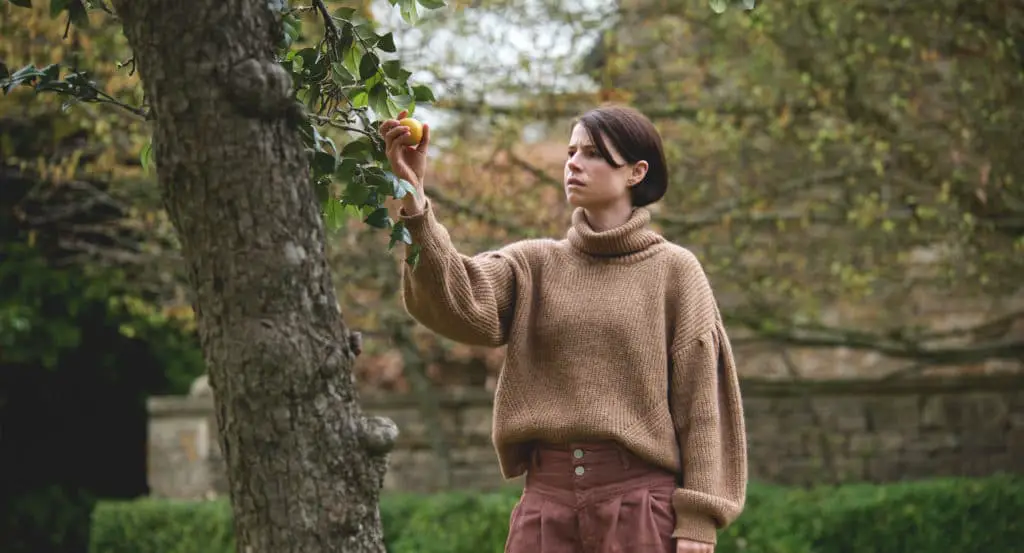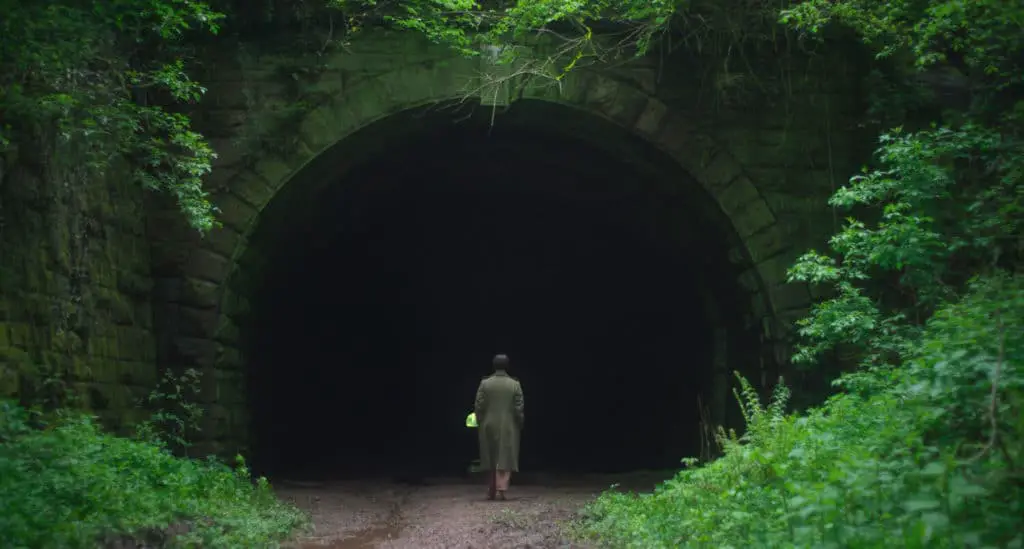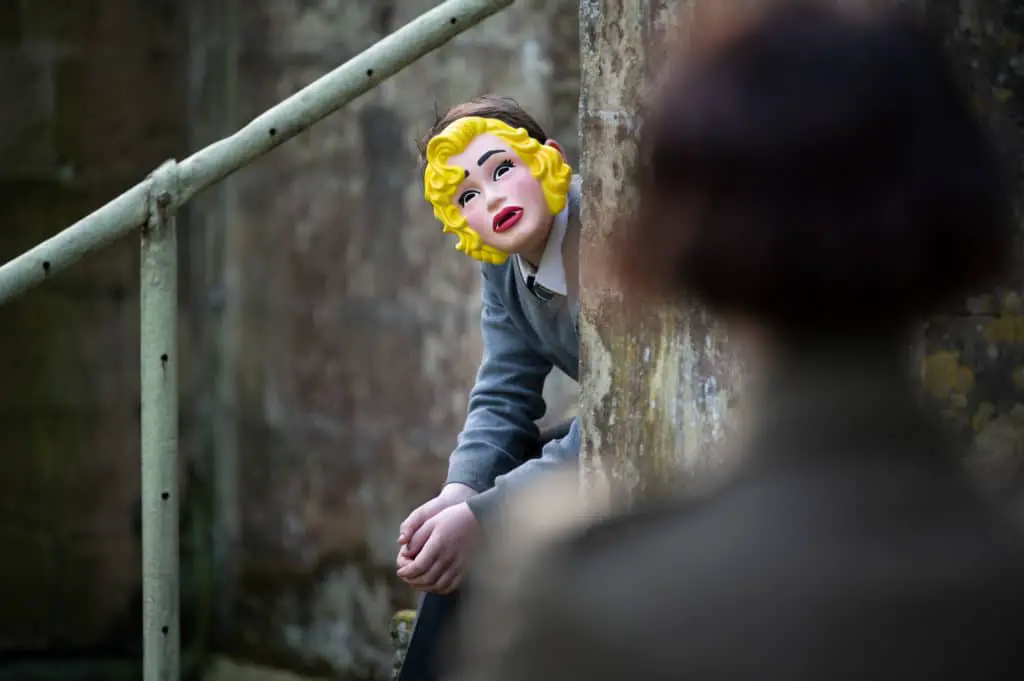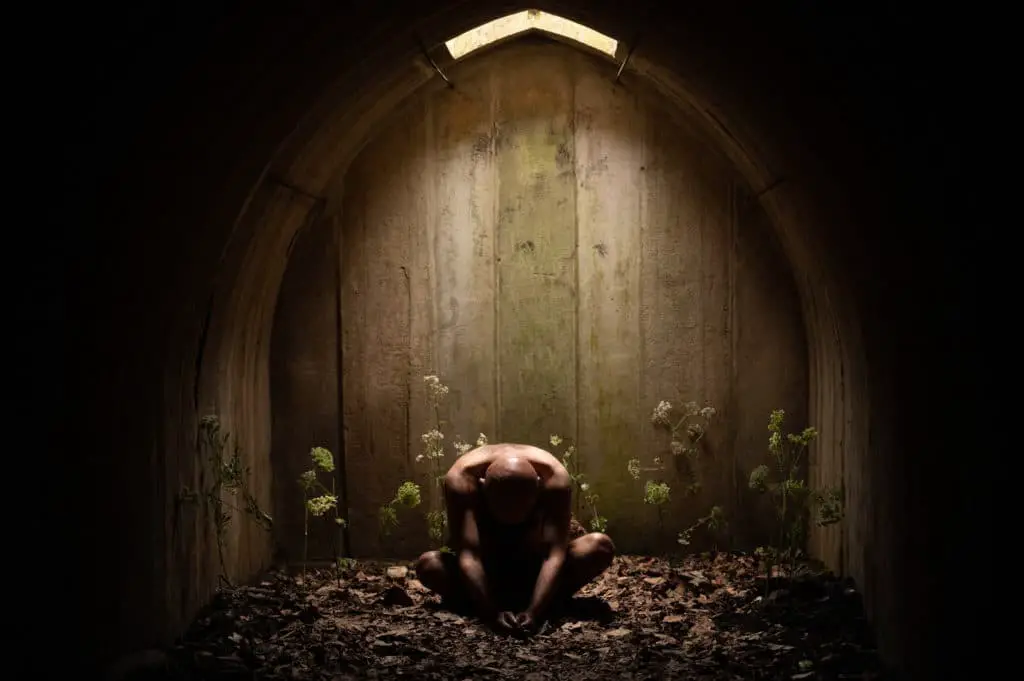Apples, Raven, Green Man: What Is The Essence Of The Thriller Men? Men (2022): The Meaning Of The Film, Explanation Of The Plot, The Essence Of The Ending, Similar Films.
Country: United Kingdom
Genre: Horror, Thriller, Mystery, Drama, Art House
Year of production: 2022
Director: Alex Garland
Actors: Jesse Buckley, Rory Kinnear, Paapa Essiedu, Gail Rankin
tagline: You can’t run away from this
Original title: “Men”
Despite being full of references and symbolism, many people interpret the meaning of the film Men (2022) quite simply and unequivocally – as another ode to feminism and criticism of male masculinity. In particular, a shocking ending prompts such an explanation. Let’s see if this interpretation is fair and what exactly the director was trying to convey to the audience.
What is the movie about
In the first scene we see the main character named Harper. She looks out the window, dumbfounded, as her husband flies by. This is a memory to which she, along with the audience, will have to return. In the present, we see an idyllic picture of the British hinterland. In an open field, the wind blows the seeds off the dandelion. Harper enters the courtyard of an old mansion, sees an apple tree, picks and eats the fruit from it. The landlord, Jeffrey, is watching the girl. He meets her and shows her the house where she wants to live for a while.
 Jessie Buckley as Harper. Frame from the film.
Jessie Buckley as Harper. Frame from the film.
In communication, Jeffrey is polite and courteous, but his smile is forced, his laughter is strained. He tells Harper that she has committed a misdemeanor: you cannot pick apples from the garden – these are forbidden fruits. However, he immediately explains that this is a joke. Jeffrey gives a short tour of the mansion. When he reaches the bathroom, he warns the girl not to throw feminine hygiene items down the toilet.
Harper is talking to a friend via video link, at one point there is interference, and we see someone’s scary twisted face. Again a memory: a conversation between the heroine and her husband about parting. The girl is going to divorce, and her husband James is in despair. He reminds his wife of the oath of allegiance that they took in the church, and declares that he will commit suicide and it will be on Harper’s conscience. She does not intend to tolerate such blackmail, her confidence in the need for a divorce is strengthened.
The girl leaves the house for a walk, makes her way through a beautiful flowering forest, stops for a while, looking at a branchy tree. It’s raining a little, thunder is rumbling. Harper smiles and closes her eyes – she seems to be happy now. The rain stops, the girl comes to a long tunnel, inside of which there are puddles of rainwater. She sings a few notes – a bizarre echo sounds. The girl laughs. But then, at the opposite end of the tunnel, she notices the silhouette of a man who begins to approach her. Melodious overflows are replaced by an ominous echo of the cry of a raven.
Fleeing from his pursuer, Harper skips the path leading to the house and comes to another tunnel at the opposite end of the road. Before that, a dandelion seed flashes in the air. The tunnel is built up, but there is a door. Harper does not approach her and climbs up the ravine. At the edge of the forest, the girl stumbles upon long-abandoned buildings. Out in the field, she takes a photo and sees a naked man among the ruins – probably her pursuer.
 Frame from the film.
Frame from the film.
Harper’s memory: her already dead husband James, who jumped out of the window, hangs covered in blood on an iron fence on a pierced arm.
The heroine sends a photo of a naked man to her friend, she writes in response: “OMG” (short for “Oh My God” – “Oh my god”).
Having calmed down, Harper plays the piano and a little later, showing the situation in the mansion via video link, demonstrates a musical instrument and to the question “Do you play?” replies with a slight reproach “Yes, actually!”. During the conversation, the heroine again sees a naked man who walked around the garden and watched her. Now he is examining the apple tree and seems to find it missing. Harper calls the police, and the man tries to break into the house.
Flashback: The heroine writes to a friend about her husband James: “He doesn’t stop. I do not know what to do. He scares me.” He sees the message, makes a row, asks to unlock the phone and, in response to the phrase “This is my phone,” hits his wife in the face.
A naked man is caught by the police. Harper testifies, talks with a friend and goes to a local Catholic church. In front of the altar stands a stone statue, on one side of which, it seems, the head of the Green Man, a male character who is the hero of ancient British myths, is depicted, on the other, an ancient female character, Sheela-na-gig, is also depicted.
Harper remembers shooing James away after the beating and screams. The priest hears it. On the street, the girl sees a boy in the mask of American film actress Marilyn Monroe. He offers to play hide-and-seek for Harper, but she says she’s not in the mood. The conversation is interrupted by the priest. The boy leaves, throwing insults at the girl.
 Zach Rothera-Oxley as Samuel. Frame from the film.
Zach Rothera-Oxley as Samuel. Frame from the film.
Harper tells the story of how she quarreled with her husband, how she chased him away in response to a beating, and how he jumped or fell from an upstairs window. The priest pretends to understand and accept the interlocutor, but puts pressure on the feeling of guilt, saying that the girl should have given her husband a chance, that men beat women from time to time and this is normal. Harper sends the preacher to hell and leaves.
The viewer is shown the dead carcass of a deer, from the darkness of his eye socket appear images of Shila-na-gig and the Green Man, which we have already seen in the temple. The camera pulls back to show the already rotting carcass of the same animal being eaten by worms. The naked man Harper saw inserts a green leaf into his head, becoming like the Green Man.
Evening comes. Harper comes to a bar where the owner of the mansion, a policeman and several other similar visitors are located. The police officer reports that the naked man who pursued the girl was released because he had nothing to show as charges. Harper, indignant, leaves the bar. On the dark road, she again hears something similar to the cry of a raven.
Harper returns to the house and complains to a friend via video link about his misadventures. The girl is ready to get into the car and leave this place. However, the friend says that it is not worth changing plans because of some freak, that she herself will come to the village and jokes that if the villain appears again, she will chop off his manhood with an ax. Harper tries to relay the address over the phone, but the connection is interrupted. In her chat with her friend, the message “I already know where you are” appears and the same insult that the boy threw at her at the temple.
Flashing light. In the yard, Harper sees a policeman, he does not respond to his appeal. The policeman suddenly disappears, apples begin to fall from the tree. Another man runs towards Harper. The girl locks herself in the house, but it seems that someone has already entered there – there is a roar and the sound of broken glass. Jeffrey enters the house, supposedly having heard the noise and screams, and now portrays a savior trying to sort out the situation. He enters the kitchen and finds a wounded raven there. Jefri kills the bird by snapping its neck. The landlord recalls the words of his father, who said that he would never make an intelligent military man. Now Jeffrey allegedly intends to prove that he was wrong.
 Rory Kinnear played the role of Jeffrey. Frame from the film.
Rory Kinnear played the role of Jeffrey. Frame from the film.
The landlord disappears, instead of him appears the same naked man with green sprouts sticking out of his body. It blows on the palm and dandelion seeds fly into the air. Harper inhales them. Again, shots flash with the Green Man and Sheela-na-gig on a stone, with a barricaded tunnel. The girl is back in the house, a naked man is reaching out to her. Harper holds out his hand in response – the man squeezes it tightly and pulls on him. The girl plunges a knife into the attacker. He continues to pull his hand in his direction and thus cuts his flesh.
A boy appears in the room. He has the same cut arm. The boy blames Harper for hurting him and offers to play hide and seek. Harper counts to ten, but doesn’t hide. Instead of the boy, a priest also appears with a wounded hand. He quotes a verse with the plot of the myth of Leda and the Swan and in response to the question “What are you?” replies: “Swan”. The priest describes his lustful fantasies, says that a woman’s sexuality is her power and control, again sprinkles quotes and approaches Harper closely. The girl fights back, again stabbing the villain with a knife.
The heroine tries to leave by car, but knocks down Jeffrey standing on the road. He gets up, throws out Harper and gets behind the wheel himself. The girl rises and sees a huge starry sky above her.
Now Jeffrey is chasing Harper in a car and crashes into the fences near the house. The naked man appears again, already with flowering branches and leaves on his head – now he is exactly the Green Man that was depicted in the temple. He lies down, spreads his legs – between them is the female genital organ, from which a boy familiar to the audience appears. He, in turn, gives birth to a priest, and he – Jeffrey.
Harper is no longer afraid – she looks tired, but calm. From the crying Jeffrey, the deceased husband of the girl James appears. Harper picks up an axe. Jeffrey sits down on the couch and calls for a look at it. He states that the wounds received by his incarnations during the confrontation with the girl correspond to the injuries that he received when falling from the window. Again there is an accusation.
Harper asks “What do you want from me?”. James replies: “Love.” The girl smiles sadly and tiredly.
In the morning, Harper’s friend (who turned out to be pregnant) drives up to the mansion, sees signs of a confrontation with men and the girl herself. She sits on the street, twists a green sprout in her hands and smiles.
The meaning of the film
Director and screenwriter Alex Garland filled the film “Masculine” with many symbols, the meaning of each of which can be interpreted in different ways. However, it is interesting that, regardless of the content of the interpretations, most likely, you will be right in the main thing and one way or another will catch the idea that was laid down. After all, in fact, even those who believe that this is a movie “for women and against men” are right, only they see only the tip of the iceberg. Let’s try to make our analysis of the main points and delve deeper into the essence of the film.
So, the picture begins with a reference to the biblical myth of the forbidden fruit from the tree of the knowledge of good and evil, which Eve plucked, for which she was expelled from Paradise to Earth along with Adam. The owner of the Jeffrey mansion, watching the heroine and reproaching her for her misconduct, behaves like a god with power. In addition, he reminds the girl of her “unclean nature” by talking about feminine hygiene products.
Jeffrey is trying so far gently, but to instill a sense of guilt in Harper. Absolutely all the male characters in the village are doing this one way or another, thus broadcasting the position of the deceased husband of the girl James.
The branched tree that Harper sees on a walk symbolizes, perhaps, the male race, but rather, in general, the human race, rooted in the depths of centuries. The scene in the rain is intended to show how ancient people, being in unity with nature, with the Garden of Eden, and not delving into the differences between the female and male sex, were happy.
Then comes the knowledge of “good and evil”, more precisely, male and female. First, Harper comes into contact with his feminine through a moisture-filled tunnel (obviously a symbol of the female genital organ), experiencing joy. Then a naked man breaks the idyll, chasing the heroine to the opposite tunnel – the male one, into which the passage is closed. His run is accompanied by the cry of a raven, which in many religions is a bad omen, in the Christian tradition – the personification of the forces of hell and the devil.
When Harper shows a photo of a naked stalker to a friend, she writes an abbreviation for “Oh my god.” Thus, we are given to understand that this representative of the male gender, like Jeffrey, fancies himself a god, in fact being, rather, his opposite. In confirmation, the pursuer portrays the owner (“god”), who discovered the loss from the “tree of paradise”, but breaks into the house like a fiend.
 the role of James was played by Paapa Essiedu. Frame from the film.
the role of James was played by Paapa Essiedu. Frame from the film.
This is how the director mixes biblical and pagan mythology from the very beginning (starting with the subsequent scene in the temple, this becomes more and more noticeable), gradually intensifying the conflict between the feminine and the masculine. And although the first is presented as good, for which one wants to root, the second as a frightening evil, we are still hinted that the heroine is not without sin. She lied to Jeffrey about not playing the piano. Although in a conversation with a friend, she is even slightly offended that she is not aware of her ability to play music.
Further in the temple there are hints “on the forehead”: the Green Man and Shila-na-gig. The first is a character featured in many ancient cultures around the world. It is usually depicted as a humanoid face surrounded by leaves or, rather, growing with them. The green man is associated with the male side of the force of nature, with rebirth, with the beginning of a new spring cycle of life.
Further, according to the plot of the film, a naked pursuer will be reincarnated into him (the first scene of reincarnation alternates with the “revival” of a dead deer, which becomes food for representatives of a new life). Sheela-na-gig is another ancient character who personifies the feminine side of the force of nature and is often depicted as a woman with a hypertrophied sexual organ.
The men surrounding Harper in the village behave like aggressors: the priest accuses the girl, the teenage boy (in the mask of Marilyn Monroe, an actress who suffered from male attention) insults, the policeman releases the pursuer. The director deliberately portrays them as similar to each other – it is no coincidence that the same actor plays all of them. The pressure of men becomes more and more intimidating and takes on a mystical character: they reincarnate into each other, frightening Harper. The landlord Jeffrey seems to be the most adequate of all, although in reality he only portrays a brave defender, in the finale he turns into an open aggressor. Jeffrey’s words about his father are another hint that he is an integral part of the male race that pursues the heroine.
Harper inhales dandelion seeds (“male seed”), which flickered in the frame throughout the film: the world of men penetrates deeper into the heroine, trying to master her. However, the girl does not give up, injuring her pursuers. However, they themselves provoked her – all so that James once again showed his wounds and blamed Harper again.
The most interesting thing in the scene of the attack of men on Harper is the speech of the priest. He calls himself the Swan and mentions the myth of Leda and the Swan. Brief description of the myth: captivated by the beauty of the girl, the daughter of the Aetolian king Thestius, the god Zeus appeared in the form of a swan and took possession of her. The erotic component of the myth inspired many sculptors, painters and poets. In fact, this scene is a continuation of the main line of the film: a man who thinks he is a god, blaming the girl (this time for her sexuality) is trying to get her.
Before the final scene with the literal rebirth of men, Harper sees a huge starry sky, the Milky Way – another symbol of the feminine.
 Frame from the film.
Frame from the film.
So, throughout the film, men accuse and persecute the heroine, declaring that she is their property. What does all of this mean? Sick subconscious Harper, psychologically traumatized by the death of her husband? The embodiment of abuse? Perhaps yes. But the main point is to demonstrate the difference between the man and female worlds. The first from the most ancient times tried to take possession of the second, using all possible methods from direct aggression to seemingly harmless manipulations.
Women were driven into frames, they were told that they were weak and must obey. But now everything is changing: men are gradually losing their power and even becoming miserable. This explanation of the film Men is fixed by its final scene.
Ending explanation
The meaning of the shocking ending of the film Men is in an exaggerated demonstration of the same thing that was shown before: the incessant attempts of men to make women their property. Trying to penetrate the world of the latter, the former literally adopt their traits, turning into women in childbirth.
The hidden meaning of the shown cycle of reincarnations lies in the role played by each of the men. The first generation is represented by the Green Man, an archaic character who came either from the biblical paradise, or from pagan chaos. The second is an evil boy, the embodiment of a male aggressor from ancient times. He demands attention, demonstrates open aggression (“whoever didn’t hide, I’m not to blame”) and gets angry when he doesn’t get what he wants.
 Frame from the film.
Frame from the film.
The representative of the third generation is the priest, the male seducer. He knows how to present himself beautifully, to charm with sweet speeches, but his goal is sex. This is a man from the Middle Ages. Jefri is a male protector from the new time. He cares about the woman, inferior to her in many ways, trying to create her comfort and security. But at some point he becomes the aggressor.
The cycle is completed by the representative of modern times, James. He is a vivid embodiment of the crisis of masculinity. This character is morally weaker than the previous ones, but still wants to get a woman in his property, although he says that he wants love. That is why Harper, in response to James’s words, smiles so sadly: she has become strong, escaped from man oppression and sees all his pitiful manipulations.
In such an explanation of the ending and the entire film, there is no humiliation of manhood, which many have seen here. Rather, it is an attempt to describe the relationship of women and men in history and mythology through the centuries with the help of symbols. Everyone will find the deep meaning in this for himself, but it seems that the director is calling us to mutual understanding. It’s time for men to stop being possessive towards women, and it’s time for women to stop seeing men as manipulators and aggressors (as Harper does through the prism of her subconscious). It is worth, bearing in mind all the gender differences and contradictions, to learn to see the good in each other.
Similar films
- “It” (USA, 2014): not a screen adaptation of Stephen King, but an independent work that skillfully plays on the fear of persecution;
- “Mother!” (USA, 2017): horror film – metaphor from Darren Aronofsky;
- “Antichrist” (Denmark, 2009): a spouse who has lost a child plunges into the abyss of madness – horrors from the cult auteur film director Lars Von Trier;
- The House on the Other Side (USA, 2020): A widow tries to unravel the dark mystery of her husband who committed suicide.







